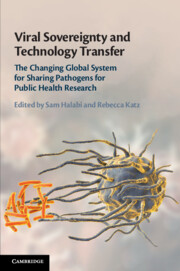 Viral Sovereignty and Technology Transfer
Viral Sovereignty and Technology Transfer Book contents
- Viral Sovereignty and Technology Transfer
- Viral Sovereignty and Technology Transfer
- Copyright page
- Contents
- Maps
- Tables
- Contributors
- Preface
- Acknowledgments
- Introduction Viral Sovereignty, Technology Transfer, and the Changing Global System for Sharing Pathogens for Public Health Research
- Part I The Geopolitical, Historical, and Scientific Context
- Part II Health Security, Research Ethics, and Human Rights Implications
- Part III Solutions: Standard Material Transfer Agreements, Repositories, and Specialized International Instruments
- 8 Material Transfer Agreements and the Regulation of the Collaborative Environment
- 9 Sharing of Biological Samples during Public Health Emergencies
- 10 Facilitating Material Transfer Agreements from a Practitioner’s Perspective
- 11 The Pandemic Influenza Preparedness Framework as an Access and Benefit Sharing Mechanism
- Conclusion
- Index
10 - Facilitating Material Transfer Agreements from a Practitioner’s Perspective
from Part III - Solutions: Standard Material Transfer Agreements, Repositories, and Specialized International Instruments
Published online by Cambridge University Press: 15 May 2020
- Viral Sovereignty and Technology Transfer
- Viral Sovereignty and Technology Transfer
- Copyright page
- Contents
- Maps
- Tables
- Contributors
- Preface
- Acknowledgments
- Introduction Viral Sovereignty, Technology Transfer, and the Changing Global System for Sharing Pathogens for Public Health Research
- Part I The Geopolitical, Historical, and Scientific Context
- Part II Health Security, Research Ethics, and Human Rights Implications
- Part III Solutions: Standard Material Transfer Agreements, Repositories, and Specialized International Instruments
- 8 Material Transfer Agreements and the Regulation of the Collaborative Environment
- 9 Sharing of Biological Samples during Public Health Emergencies
- 10 Facilitating Material Transfer Agreements from a Practitioner’s Perspective
- 11 The Pandemic Influenza Preparedness Framework as an Access and Benefit Sharing Mechanism
- Conclusion
- Index
Summary
Chapter 10 “moves” the audience out of the scientific and ethical location in the theoretically low-resource but biodiverse country, and into the negotiating room where terms of sharing human pathogens occur. With decades of experience behind them, Mowatt and Ranjan cover the importance of human pathogen sharing from the perspective of the world’s most prominent biomedical research institution, the process through which sharing arises and is negotiated, the most frequent and salient barriers to sharing including isolating pathogens in the first place and then bargaining for them, mechanisms to reduce barriers to sharing including repositories and standardized agreements. Mowatt and Ranjan spend a significant amount of the chapter discussing the evolution of standardized agreements, and how those agreements functioned in recent public health emergencies including Ebola, Zika, and MERS-CoV. The authors identify common terms and conditions, disputes over publication and use of research results, rights in inventions developed during use, liability and other concerns. They provide nuance to these broad categories including the distorting influence of perceived value of material like devices or drugs, and proposed use such as discovery, pre-clinical, or clinical application.
- Type
- Chapter
- Information
- Viral Sovereignty and Technology TransferThe Changing Global System for Sharing Pathogens for Public Health Research, pp. 174 - 192Publisher: Cambridge University PressPrint publication year: 2020


